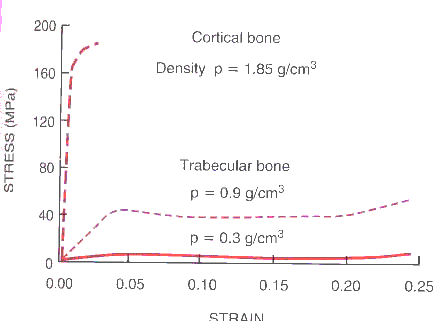5.7 Energy and its relation to material response
5.7.1 Elastic-plastic behavior
Unlabelled Image Missing
- Initial loading is “elastic” (no permanent deformation)
- unloads back to origin
- Elastic energy is stored in the material
- it can be recovered (like a spring)
- \(U=\frac{1}{2} \sigma \varepsilon = \frac{1}{2} E \varepsilon^2\)
- it can be recovered (like a spring)
5.7.2 Elastic-plastic behavior
Unlabelled Image Missing
- Loading past yield (\(\sigma_Y\)) causes permanent set
- Typical unload follows the slope of the elastic region
- Energy is dissipated as plastic work (\(W_P\))
- Loading to the ultimate tensile strength (\(\sigma_{UTS}\)) causes failure and additional energy dissipation (\(W_F\))
5.7.3 Bone density and the elastic modulus

@Browner1998
- Bone density a strong effect on modulus and other properties
- Subtle changes greatly changes strength and elastic modulus
- Density changes from:
- normal aging
- disease
- malnutrition
- use
- disuse
- …
5.7.4 Energy and energy dissipation
- In orthopaedics, two kinds of energy are of great concern:
- kinetic and potential
- Kinetic energy is the energy of a particle in motion
\[K = \frac{1}{2} m V^2\]
- Examples: gun shot impact, motor vehicle crash
- Potential energy is the energy associated with a fall from
a height \[U = m g h\]
- During the fall, all potential energy is converted to kinetic energy just before impact
- There are other relevant forms of potential energy
5.7.5 Energy and energy dissipation
- Energy is “conserved”, all energy in the system goes to something
- If enough energy is available, some goes to permanent deformation of the “structure” (bones, soft tissue, implants, etc)
5.7.6 Toughness: brittle vs ductile
Unlabelled Image Missing
- The fracture toughness is a measure of energy required to propagate a crack through a material
- Brittle materials have low toughness, not much energy is required
- Ductile materials have high toughness, much energy is required
5.7.7 Strength vs toughness
Unlabelled Image Missing
- Strength (\(\sigma_{UTS}\)) is a measure of how much stress a material can carry
- Toughness is a measure of energy dissipated during failure (crack propagation)
5.7.8 Strength vs fatigue strength
Unlabelled Image Missing
- Cyclic loading (repetitive load and unload) can cause “fatigue failures” at loads much lower than the ultimate tensile strength
- The S-N curve – plot of load vs number of cycles to failure
- Some materials exhibit a fatigue strength (\(\sigma_f\))
- The curve levels off and the material has infinite fatigue life below that stress